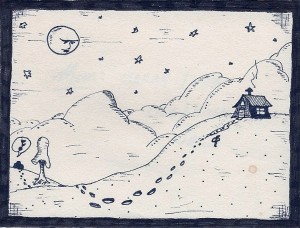
Tuesday, 2:47pm
Reno, NV
“Don’t let me be misunderstood.” (The Animals, #15 on Billboard, 1965)
Howdy…
I’ve resurrected another gem from the archives… just because it’s so freakin’ good. Many of the lessons I try to deliver in this blog need to be delivered over and over (the only guaranteed way to finally learn anything in life), and once I nail it, there’s no sense rewriting it.
The clarity I try to achieve below is a solid step toward leading a more examined life… which all great marketers strive to do. There are stages to this if you’ve hit adulthood and continue to labor under false assumptions and bad belief systems. The worst is thinking that what you believe must be true, because you’ve believed it for so long.
This kind of circular cognitive dissonance can hold you up for decades (or even forever)… because our very human minds are hard-wired to listen to our intuition, no matter how often it’s proven wrong or screws up our lives.
We’re stubborn beasts. As a civilian, you just go enjoy your bad self with your silly notions and absurd assumptions. I’d prefer that you not vote, but it’s a free country.
However, as a marketer who desires wealth and recognition and lasting success… you cannot rely on the flawed default settings in your brain. If you haven’t been constantly giving yourself vicious Reality Checks over your career, you’re risking being stuck in a non-productive zone where competitors will fly past you, and customers flee.
I, personally, am very hard on myself. Very, very hard.
My transformation into a real professional meant climbing out of a slacker lifestyle where I got away with laziness, unreliability, and a self-destructive refusal to change… Read more…

Saturday, 3:44pm
Reno, NV
“I’ll have what she’s having…” (When Harry Met Sally)
Howdy…
I figured I’d kick off the new marketing season here in a ball of fire, and just lay some Reality Checks out for you. Here goes:
Your First Big Reality Check: If you tried, really really hard, and weren’t successful last year…
… it was probably mostly your own damn fault.
Yeah, sure, the economy sucked, politicians were mean, your prospects are all screamin’ idiots, and God had it out for you. All totally excellent excuses for having a crummy bottom line again.
It’s not your fault. It can’t be your fault. That’s… that’s just…
… that’s just completely unacceptable that it even might be your fault.
And, hey, maybe you did piss off the universe, and spooky forces beyond your control mucked things up so you had a bad year.
I believe you. I really do.
However…
After you’ve been around the block a few times in life, you start to notice some very interesting things about success.
And the big realization, I’d have to say, is that the idea that success is somehow magically bestowed on people in a spontaneous burst of luck and being in the right place/right time…
… is just bullshit.
It is. It’s total bullshit. Hollywood likes to pretend it’s a real plot point. And folks clueless about how the world works — who spend their lives outside looking in — use this myth as a comforting excuse for their own lack of goal attainment.
Once you’ve spent even a little time with successful dudes and dudettes, you notice something startling: They all have well-defined goals, and they focus on nailing them like terriers going after a squirrel.
They are not stopped by lack of skill, or lack of time, or lack of connections in the right places.
They are not stopped by ADHD (which a LOT of the entrepreneurs I know are saddled with, btw)… or feelings of inferiority (many of the best are entirely motivated by “I’ll show you” revenge fuel)… or lack of education (drop-outs galore).
And they are not stopped by the main reason most wannabe entrepreneurs never get past that “deer in the headlights” pose: Not knowing what to do next.
Every single excuse ever floated by anyone in the history of mankind…Read more…

Tuesday, 2:57pm
Reno, NV
“Mongo just pawn in game of life.” (Blazing Saddles.)
Howdy…
Recently, I published a series of posts on Facebook under the theme “How To Win An Argument”. Over the week it ran, there was a vast and animated flurry of comment and interaction — the posts hit a nerve.
Fortunately, because that series got so much traction in Facebook, I decided to gather them and post the series here in the blog, so they’ll go into the archives (and thus can be easily accessed by anyone interested). I say “fortunately”, because apparently Zuckerberg and his evil Facebook henchmen decided that all my January posts before the 20th (which included the argument series) needed to vanish from the face of the earth (and the virtual earth that is social media). Poof. They’re gone. No explanation, no way to get them back (though I’ve been searching for tips and asking for help from colleagues — there are a lot of videos out there pretending to have the secret of restoring “lost” posts, but they don’t work).
I’m kinda stunned… but glad I’d already copied and pasted those initial posts here. I’m doing the same with other FB posts from the past — just getting them copied into a Word doc, in case Zuck goes berzerk again. Jeez Louise, you probably need to take the same precautions if you have valuable posts you don’t want to lose.
So, Lesson #1: Do not trust Facebook to archive anything. The joint is crawling with post-devouring demons or something.
I’m not saying that everything I post there needs to be carved in stone. But I do write some cool shit on my wall, occasionally. It’d be nice if it remained there.
Anyway, below is a mildly-edited collection of that series on winning an argument. I didn’t save the dozens and dozens of comments, and that’s a shame — it was a great thread, full of other lessons. For example: The easiest way to get a whole bunch of folks frothing is to talk about (a) sex, or (b) their belief systems. They go nuts. As you’ll see below, I just laid out my views on how to handle people who want to argue and how to define “winning” for yourself… and that just pissed off some folks. Even discussing arguing inflamed their knee-jerk need to argue. Humorous, ironic, and illustrative of how whacko human beings can be. Also, as a marketer, informative — especially if you want or need to introduce some form of argument or alternative view into your advertising.
And, yes, this entire series is very much aimed at marketers. Great ads seldom argue, though they may be pushing buttons right and left. The psychology is subtle, but awesome.
So, without further ado, here’s that series. Love to hear your comments… which will all go safely into the blog archives, where Zuckerberg can’t touch them:
How To Win An Argument, Step 1: The primary rule is simple — never Read more…

Special Note If You’ve Just Come Here From My Facebook Rant On Winning Arguments: If you’re looking for a fast, thoroughly fun way to quickly learn high-end salesmanship skills… for a screaming bargain, no less… grab a copy of my must-read book “Kick-Ass Copywriting Secrets of a Marketing Rebel” here.
Okay, on to the current blog post:
Saturday, 1:30pm
Reno, NV
“Hey, you bastards, I’m still here!” (Steve McQueen as Papillon, floating away to freedom…)
Howdy…
I’m re-publishing — for what has become a very popular tradition on this blog — one of the more influential posts I’ve ever written.
What you’re about to encounter is a slightly tweaked way of looking at the best way to start your new year…
… but this tweak makes all the difference in the world. I’ve heard from many folks that this particular technique finally helped them get a perspective on where they’re at, where they’re going…
… and why they care about getting there.
So, even if you’ve read this post before… it’s worth another look. Especially now, as you gaze down the yawning gullet of 2013, trying to wrap your brain around a plan to make the year your bitch.
This is a critical step for entering any new period of your life. To keep your life moving ahead, you need to set some goals, dude. And most goal-setting tactics, I’ve found, are useless. Worst among them is the traditional New Year’s resolutions (which seldom last through January).
This tactic I’m sharing with you (again) is something I’ve used, very successfully, for decades…Read more…

Wednesday, 10:36pm
Reno, NV
“To the moon, Alice!” (Ralph Kramden)
Howdy…
I’m recycling a post from a little while back, because it’s on a subject that can never be discussed too many times…
… especially when it’s important that you establish a real, visceral connection with people to make your business work.
In fact, what I’m bring up here is much more critical to creating effective advertising than many of the obvious things people tend to focus on (like “long copy versus shot copy”, or how to test offers).
Listen: If you understand how to use the powerful tool explained below…
… you can screw up almost every other part of creating your ad (or video, or website, or email, or whatever you’re using to get your story across)… and still crush it with results.
So ignore the details in this dusty post (like references to “Six Feet Under”, that great HBO series now long-gone)…
… and know that the insight revealed here will forever be one of the most influential you’ll ever use in marketing.
In fact, it’s just becoming more and MORE important as social media and info-overwhelm continues to nudge everyone toward ADHD-Land, where attention spans are pathetic and fundamental human emotions like empathy wither.
Here’s the post (with a few edits and some added stuff):
Jeez Louise. Did you catch Sunday’s episode of “Six Feet Under” on HBO, with the jarring funeral scenes?
It was… shattering.
I was jarred back to every funeral I’d ever attended, and had emotions wrung out of me I’d long forgotten about.
Screw reality TV. The truly well-written fictional shows (most of them on HBO) can still rattle your cage like classic literature.
That episode was quality emotional-wringing.
Got me thinking, too. About empathy. And writing.
I’ve known people who seem to have shut down their empathy gears… and it becomes evident when they lose the ability to get outside of themselves and see the world from other people’s viewpoint. Movies require you to emotionally connect with the characters…
… and I recall uncles who fell asleep during the pea-soup-spewing scenes in “The Exorcist”…
… friends who laughed all through “Jaws”…
… and (in a real-world example) even an acquaintance who wondered what the big deal was when a colleague freaked out over a cherished cat’s sudden demise.
I also first saw “Saving Private Ryan” with a friend who was still a little shaky over his years in Vietnam during the war. He’d asked me to see it with him for moral support… and while he didn’t seem to have a tough time watching the movie, I kept an eye on him anyway, not sure what sort of poison might be brewing back up.
Those three films — and my experience with pets and people dying and careers ending and relationships imploding — were all emotionally jarring on various levels. And they were executed by master craftsmen, using scripts written by writers who knew where the tender spots were in most audiences.
I always feel a little estranged from people who either are — or claim to be — removed from emotional reactions.
In real life, we mostly experience things from inside our heads or along the contours of our immediate senses. It’s a claustrophobic point-of-view even the best Hollywood-quality cameras can’t yet mimic. In real life, everything happens just outside (or just within) our personal space, moment by moment, with no editing and no replay button.
When you personally feel emotional trauma, it’s a shock-inducing trial by fire that consumes you.
However, watching a TV show or a movie is a removed experience — pure voyeurism. You’re not there. It’s not happening to you. It shouldn’t have the same power as real life.
And yet… sometimes all the emotion of the real experience IS there, bubbling up from deep inside.
All the good writers I know are drenched with emotional self-knowledge and empathy for the emotional experiences of others. We aren’t walking around sobbing hysterically… but we are easily overcome with the feeling of a situation.
Sometimes Read more…

Saturday, 3:17pm
Mendocino, CA
“Under my thumb is a squirming dog who just had her day…” (Stones)
Howdy. I’m republishing this article from 2010, cuz it was one of the most-discussed and helpful posts I’ve written. And it’s on a subject most biz books not only ignore, but aggressively seek to dismiss. Yet, in my decades of consulting, I see it bubble up in nearly every entrepreneur I meet at some point.
So, enjoy another nugget from the archives. (And I hope you didn’t eat much — again — at Thanksgiving…):
Friend…
Do you suffer from the heartbreak of envy?
Are you jealous of friends and colleagues who attain success, while you continue to struggle?
Would you like to learn a simple cure for feeling inferior to others?
Well, then step right up…
Here’s the story: I grew up with the definite impression that ambition was a moral failing. The operative phrase was “Don’t get too big for your britches”…
… which was a cold warning to anyone who dared attempt to rise above their (vaguely defined) place in life.
And one of the greatest joys was to gleefully watch the collapse and humbling of the High & Mighty. I believe there’s some evolutionary fragment left in our systems that wants a solid check on keeping folks from leaving the pack.
Now, if you risk failing and succeed, that’s great. We were there for ya the entire time, Bucko. Rooted for ya. Got yer back.
I think our innate need for leadership allows for a select few to “make it” without hostility. And, as long as they provide whatever it is we need from them — protection, entertainment, intellectual stimulation, decisive action, look good in a tight sweater, whatever — they get a pass.
But we seem to have a ceiling of tolerance for others moving up the hierarchy too fast. Whoa, there, buddy. Where do you think you’re going?
And when the unworthy grab the brass ring, it can trigger a hormone dump that’ll keep you up all night. Because, why did HE make it, when he’s clearly not the right dude towin. This is totally fucking unfair, and makes ME look bad now.
The lucky creep.
I hope he screws up and gets what’s coming to him…Read more…

Wednesday, 12:53pm
Reno, NV
“I’m busy 24 hours a day, I fix broken hearts, I know that I truly can…” (Del Shannon, “Handyman”)
Howdy.
Today, I want to share with y’all a simple pro-level tactic that just might change your career path forever… if, like most entrepreneurs out there, you’re laboring under a huge and common misunderstanding of how things work in the real world.
Here’s the problem:
Most folks only see the surface of the culture, and seldom get to peek behind the curtain to see the infrastructure that supports everything.
Now, if you’re stumbling through life as a slacker or a follower… just bobbing to and fro like flotsam… then learning how stuff gets created isn’t important.
But entrepreneurs do not have that luxury. Once you take responsibility for the survival of a business, you better get hip to the Big Picture.
This means understanding the process of arriving at a finished product.
Which requires rolling up your sleeves and getting dirty (or virtually dirty, in the digital world).
Looking for more insight into the not-so-obvious ways to grow your biz? Then get on my email list pronto – where you’ll also get my free report, 11 Really Stupid Blunders You’re Making With Your Biz & Career Right Now. Did I mention it’s free?
Here’s the quick tale of how I was introduced to this realization:
Back in school, I was that doodling kid who just kept getting better at it… until one day the journalism teacher found one of the endless homemade comic books I was pumping out, and insisted I create a weekly cartoon for the high school newspaper.
Now, I loved the comics page in the local rag (the LA Times). The idea of drawing a comic strip of my own, however, was terrifying. I didn’t have a clue how they were actually made. Up to that point, I drew only in pencil, on big sheets of scrap paper, with no limits to sizing or length. Now, suddenly, I had to work in ink, inside a 3-inch by 4-column format.
And meet a deadline.
In retrospect, I should have just hit up the art teacher for tips on producing a cartoon in a publication. Or called up the local “real” newspaper and ask a production artist how it’s done.
But I had never had to research anything before. Like most American kids, I had spent my youth tearing things apart, not building them. I’d never asked anyone how something was done, ever. I just figured it all out for myself, in my own idiosyncratic way, thinking that’s how it had to happen. You “should” be able to figure everything out.
It’s a flaw in our brains.
Back then, the hard part of doing a weekly cartoon was coming up with jokes that fit into a four-panel format. But what consumed the most time was producing the final strip. I bought a double-aught nib in a wooden holder at the crafts store, plus a big bottle of India ink.
And I drew veeeeeeery carefully…
… because I believed that published cartoons were drawn that way.
You know, that Charles Schultz just sat down and inked out a Peanuts strip from left to right.
And if I made a mistake, I was screwed.
Had to start over on a fresh sheet of paper.
Now, I’m a slow learner. Really slow. I drew freehand for two years in high school, and then for another two years in college (when the editor of the paper discovered I could draw and tricked me into doing a Zap Comix-like strip in the UC Davis Cal Aggie).
It was painful to work in ink like that, knowing any mistake meant starting over.
And then I finally took a class in commercial art.
Where I discovered 3 little secrets that would later catapult my freelance copywriting career.
Because, d’oh….
I learned that:
(1) pro cartoonists and illustrators worked in “blue” pencil first (which doesn’t show up when the art is photographed for final printing)… so they could be as messy as they wanted as they built up the art to final form and inked it…
(2) they worked in a very large format, using many different sizes of mechanical pens, and shrunk the art to the final size photographically only after they were done (which also shrinks small mistakes and makes for a very “clean” look)…
(3) … while using all kinds of white paint, cut-out slivers of masking tape, and pasted-on corrections in the process… so the actual art (before it was photographed) looked like a triage patient from a plane crash. And yet NONE of the fixes, additions, corrections and sloppy blue-line noodling showed up when the cartoon was printed.
This just blew my mind.
All of this equipment and know-how was readily available at the newspapers I’d worked for. I’d just never asked. The editors relied on blue pencils and stet cameras and paste-up magic… every page was a mess as it headed to final art.
This simple discovery caused something critical to snap in my brain.
I was finally FREED from the shackles of self-imposed perfectionism.
Now that you know that the process in creating anything brilliant is messy at first, how about giving another shot at that freelance writing and consulting career? You’ll get all the secrets in the Simple Writing System right over here.
I could draw as loosely as I wanted to, populate or depopulate the art with characters on a whim, and I never had to start over from scratch no matter how ugly my mistakes were. I could fix anything.
This was a freaking revelation that helped me transform myself into a high-level freelance copywriter almost immediately after launching my career.
How? By applying the same tactic of “building up” my ads, rather than trying to create something perfect on the first draft.
The majority of entrepreneurs I counsel believe, at first, that when writing their own advertising they need to start with the headline and progress logically through the copy to the final pitch.
I know where that belief comes from, too. The ads they see in the wild are finished products. All the work that went into creating that finished product is invisible. There’s no “infrastructure” to an ad, no curtain to peek behind once it’s posted or printed.
So, for Lesson One, I make it clear that all top writers build up ads, rather than just write them out in a single burst of inspiration.
For example: I almost NEVER write the headline first. I write out the BULLETS first… because good bullets fuse the features and benefits of a product, and that gives you deeper insight to what’s good about the thing and how it will affect your prospect.
And… I write pages and pages of bullets. Most of them will never find their way into the final ad. I write them out sloppily, then go back and rewrite them. And rewrite them again a day later. And toss some, bring in new ones, merge and split others. Again and again and again, right up until the deadline.
When I feel ready to write a headline… because after all those bullets, I’m now totally conversant with the inner workings of the gig (both technically and emotionally)…
… I start slamming a bunch out, just ripping through basic “how to” models to get the juices flowing. (I always recommend you start with a “how to” type of headline, and just write out what you’re offering to the reader.)
It is not unusual for me to write up 50 or more different angles of headlines, and massage them all through multiple drafts.
Then, set the mess aside.
Don’t choose one yet.
Instead, while getting “cold” on the heads (by not thinking about them for a day or two) I’ll either work on the opening paragraph (very crucial, because you’re doing the hard work of dragging your reader into your copy) or the final “here’s what you need to do now” part of the pitch.
The point is this:
Early drafts are a mishmash of sections, in various states of being finished, over a period of time…
… and to the uninitiated eye, the whole thing looks like a house torn apart before being remodeled.
Total chaos.
The “art” of creating a finished ad is in the final stages where everything is dovetailed together. And rewritten to be a smooth, greased ride for the prospect (who, when you’ve done it right, will climb onboard at the headline and not be able to leave the ad until he arrives, breathless and shaking with desire, at the order form).
Just get over your bad self. No one who writes ads for a living starts with the headline and just writes it all down from there, perfect and ready to go. And if the pro’s don’t do it that way, you shouldn’t either.
Perfectionism sucks.
The finished product may approach a sort of awesomeness, but it’s almost never “perfect”.
Even top Hollywood directors known for producing lush, slick, technically-seamless movies (Ridley Scott and James Cameron come to mind) GET to that final point through years of prep and detail and misfires.
The key to good marketing is understanding how some parts are cobbled together, while other parts are burnished to a craftsman’s shine over time… and learning to follow the same guidelines when doing it yourself.
Realizing that final products are often attained by knowing how to FIX mistakes made me fearless about being creative.
And about being productive — I was freed from the sense that I had to know precisely what I was doing or where I was going before I began any project…
… and, instead, I just got busy immediately and never hesitated to make mistakes or wander off into dark alleys (metaphorically speaking, of course). Because going from inception to finished product is NEVER a straight, clean line.
Go get messy.
Stay frosty,
John
P.S. The best thing I hear from entrepreneurs is when some piece of advice finally rams home, and that “a-HA!” moment happens. I know the next time I hear from them, they’ll be wearing success like a pro…
… so check out the bonanza of goodies right over here so I can add your success story to my collection.
(Photo credit: Cindy Shine)

Tuesday, 3:29pm
Reno, NV
“I can’t seem to face up to the facts, I’m tense and nervous and I can’t relax…” (Talking Heads, “Psycho Killer”)
Howdy…
I’ve gone back to the archives again, just cuz they’re so freakin’ stuffed with excellent posts that should NEVER fade into history.
When I find timeless posts that deliver essential tools for your Entrepreneur’s Survival Kit, I like to re-post them here (cuz I know you’re too lazy to go searching for them yourself, you dangerous slacker, you).
So, in this emotionally-charged election year, with the economy and the fate of the globe on people’s minds, I’m thinking another little primer on stress is needed. (The best advice I ever heard from a medical professional was… after I’d said “I’m not feeling so hot, but it’s just stress”… “It’s never JUST stress, Carlton. Stress is bad, bad, bad, and it’ll kill you just as readily as having a piano drop on you from the 6th floor.” That woke me up to the reality of the chemical stew I was brewing in my system, bubbling with bad hormones and corrosive juices.)
We’re not built to survive on a steady diet of stress. We self-destruct when it gets too severe.
Okay, here’s the post. See if you can relax enough to at least read it…
——————–
Howdy.
What’s the matter, Bunky?
The news got you down? The economy keeping you up at night? Are sales in the toilet, creditors stalking you, clients not returning calls, the sheer angst of living in a modern tech-drenched world chewing holes in your gut?
Would you like to hear how grizzled veterans handle the evils of stress?
It’s good stuff… because, as everyone should realize, you don’t get to BE a grizzled veteran if you can’t handle stress. Cuz that shit will eat you alive and send you to an early grave.
In fact, this is easily one of the fundamental tools for surviving the Never-Ending Cage Fight O’ Bidness. I noticed, in the first years of my freelance career (when I was searching semi-desperately for clues on how to become successful), that there were biz owners who were having fun… and there were other owners not having any fun at all.
Age had nothing to do with it. Nor health (though the fun-havers consistently were in better shape). Nor gender, nor — and this is important — Read more…

Saturday, 11:29am
Reno, NV
“She’s so fine, there’s no telling where the money went…” (Robert Palmer, “Simply Irresistible”)
Howdy…
I’ve been counseling entrepreneurs (both rookie and veteran) for, oh, about 30 years now. They come to me when their progress, or dreams, or plans have been hijacked by events or forces seemingly beyond their control…
… and they need a hard-core reality check, fast. Plus a detailed list of steps to fix things, and get back on track.
Even if you get an MBA somewhere (and while studying the history of biz and learning the methods behind success are important, I have yet to meet an entrepreneur who was helped by getting a fancy degree like that)… you can’t really understand the cycles, problems, surprises, horrors and pleasures of running your own biz until you dive in.
You can read every book ever printed (or watch every video) on what’s it like to run a biz… but you won’t truly understand how it all works until you’re actually running ads, setting up deals, shipping product, hiring and firing and moving and shaking.
When you catch yourself looking over your shoulder at the competition the first time (or waking up in the middle of the night with angst over a new campaign), THEN you know you’re a real entrepreneur.
I really enjoy consulting with entrepreneurs whose noses have already been bloodied. Life has already done the hardest part of my job for me… by kicking the idealism and dumb-ass belief systems to the curb. Your biz won’t succeed because you’re a sweet guy, or because dammit, your product is just the greatest thing ever.
No. Your biz will succeed becauseRead more…

Saturday, 2:33pm
Reno, NV
“When I look back on all the crap I learned in high school, it’s a wonder I can think at all…” (Paul Simon, “Kodachrome”)
Howdy.
As I was writing a new article to post here, I used a term I invented: “Critical Think”. It’s not all that original, as ground-breaking terms go… but the idea behind it is very important for anyone seeking to move up a level or two in their career (or in their quest for ultimate happiness).
So, I’ve dug up the post where I first explained Critical Think, and I’m dragging it back onto the dance floor.
Really, this is timeless stuff. Enjoy:
Howdy.
Someone recently asked me to offer a clue on how to nurture critical thinking.
It’s a fair question. And while I’m no neuro-scientist, I talk about critical thinking a lot, because it’s the foundation of great writing, killer salesmanship, and engaging the world with your throttle wide open.
However, it’s not an easy subject to grasp if you’ve seldom taken your brain out for a spin around the Deep Thought Track (as most folks have not).
So let’s explore it a little bit here…
Critical Think Point #1: Yes, I know the headline on this article is a grammatical car wreck. It should be “how to think critically”, or at least “how to critically think”.
But this botched phrasing is actually part of the lesson I’m sharing here.
Consider: The vast majority of people sleep-walk through their lives and careers, never going beneath the surface of anything. They process, at most, a small fraction of the information they see, hear or read about.
It’s pretty much GIGO. Garbage in, garbage out.
So the first job of any good marketer is todeliver some level of brain-rattling wake-up call for the prospect. To literally jolt them out of their semi-permanent reverie, and initiate a more conscious state of awareness.
Cuz you can’t expect a somnambulant zombie to be proactive about following through with your request for buying something. Or opting in. Or even just continuing to read.
Thus: Good ad writers make full use of the incongruous juxtaposition of compelling sales elements — or, for short, the “hook”.
Ideally, you want the induced “WTF?” reaction strong enough to unleash a splash of adrenaline, or even physically make ’em bolt up and take notice. (As in, “That can’t be right! This violates my entire sense of what’s real!”)
HoweverRead more…











